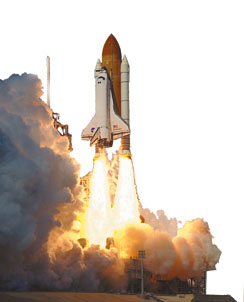
NASA
| Geotimes
Published by the American Geological Institute |
News
and Trends in the Geosciences
April 2000 |
Field Notes
Endeavour maps world

NASA |
The space shuttle Endeavour was successfully launched Feb. 11 and was maneuvered into proper orientation that evening to begin its 11-day radar topography mission, managed by NASA's Jet Propulsion Laboratory. The shuttle, which landed Feb. 22, orbited Earth inclined 57 degrees to the equator at an altitude of 240 kilometers, completing one orbit every 90 minutes. In this orbit, Endeavour used its massive radar antennae, which can resolve details as small as 30 meters across, to collect data to create 3-D maps of Earth. In one application of the mapping, researchers from Cornell University will help analyze the data to map remote areas of the Andes that have never been surveyed on the ground or through aerial photography. They hope that the results will allow them to identify active faults, and to analyze river systems to better understand the rates of uplift and erosion in the region. |
Evidence for cold subduction
Stanford University researchers investigating ultra-high-pressure terranes in east-central China, in Norway and in northern Italy have challenged the widely accepted theory that zones of very low temperatures and high pressures do not exist in Earth's interior. The most striking evidence comes from garnet peridotites - iron-rich, coarse-grained rocks with garnet inclusions formed deep in Earth - found in rocks presumed to have been carried up to the surface via asthenospheric upwelling and tectonic insertion into continental crust. The juxtaposition of mineralogical features requiring low temperatures with other highly metamorphosed minerals requires that some of the pressure and temperature conditions experienced by the rock must fall within the "forbidden zone" of high pressures and low temperatures. The findings support the theory of cold subduction and were published by J.G. Liou, B.R. Hacker and R.Y. Zhang in the Feb. 18 Science.
Soy for healthy fuel
Additives designed to boost fuel's cetane rating - a measurement of the rate fuel injected into an engine's cylinder ignites - are designed to reduce engine start-up delays that release the greenhouse gas nitrogen oxide into the environment. A commonly used cetane booster, methyl tertiary butyl ether, has recently been found to be a toxic groundwater pollutant. Researchers from the University of Kansas have developed an alternate cetane enhancer from soybean oil. Soybean oil proved most beneficial when tested in a blend of 90 percent diesel fuel and 10 percent ethanol fuel, a composition that burns more cleanly than pure diesel but does not ignite easily at low temperatures. The soy additive increased the lubricity and cetane rating of the fuel, cutting particulate exhaust emissions from a Volkswagen test engine by 30 to 50 percent. Soybean oil is effective in amounts of only 500 parts per million and is less expensive than other comparable synthetic additives.
Uranus' moons
Cordelia and Ophelia, the two rarely seen "shepherd" moons of Uranus, have been located after three years by Erich Karkoschka of the University of Arizona Lunar and Planetary Laboratory using images from the Hubble Space Telescope. The moons are referred to as shepherds because they are believed to prevent the gradual dissolution of Uranus' ring. Karkoschka found Ophelia by stacking dozens of images on top of each other and rotating them to account for the moons' orbits. Researchers from Wellesley College and Cornell University have been studying wave-like distortions of the ring using data going back to 1977 that, combined with Karkoschka's pinpointing of Ophelia, provides direct evidence of gravitational interactions between the shepherd moons and the ring. The combined data allowed the scientists to locate Cordelia as well and will allow them to make predictions for the moons' orbits for many decades.
Solar magnetism alters climate
For the first time, scientists from the Harvard-Smithsonian Center and
Long Island University have used astrophysical data of solar magnetic activity
to assess Earth's changing climate. Gaps in the outermost layer of the
sun's atmosphere,
or coronal holes, are portals through which solar wind flows out into
the solar system. The hot, supersonic particles are what cause the
aurora borealis on Earth and interfere with electrical and radio transmissions.
A comparison of globally averaged temperatures in Earth's lowermost atmosphere
to the size of the sun's coronal holes over two decades - from January
1979 to April 1998 - revealed a drop in temperature after the sun's magnetic
field activity peaked. Researchers believe that the link between
charged particles and climate may lie in the changing properties of clouds
on Earth, based on comparisons between temperature and cloud cover, but
they do not claim that their theory accounts for all global climate change.
The findings were published in the March 8 issue of New Astronomy.
Laura Wright